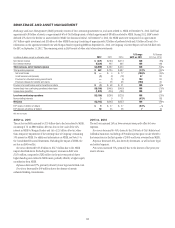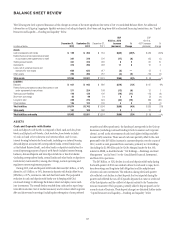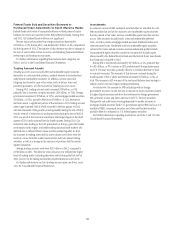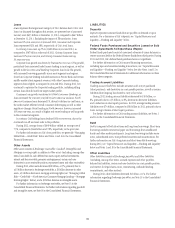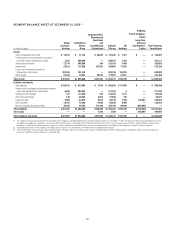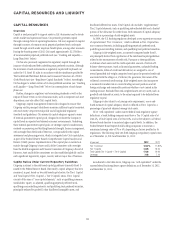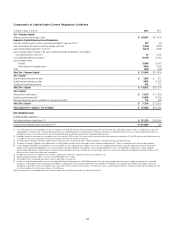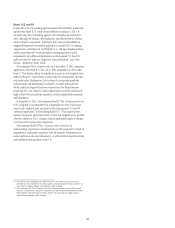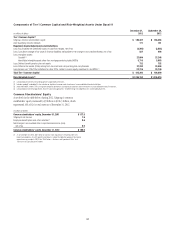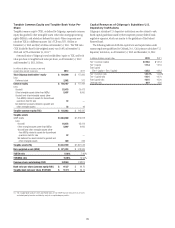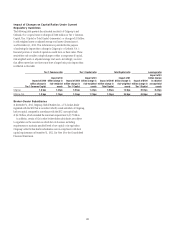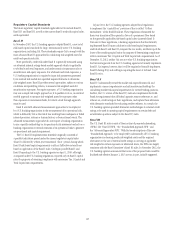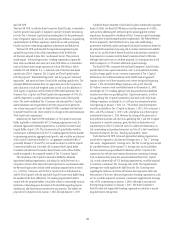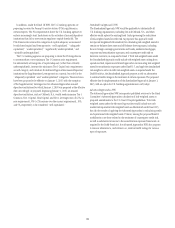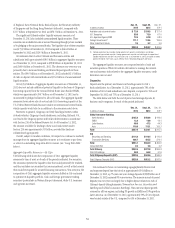Citibank 2012 Annual Report Download - page 63
Download and view the complete annual report
Please find page 63 of the 2012 Citibank annual report below. You can navigate through the pages in the report by either clicking on the pages listed below, or by using the keyword search tool below to find specific information within the annual report.
41
CAPITAL RESOURCES AND LIQUIDITY
CAPITAL RESOURCES
Overview
Capital is used principally to support assets in Citi’s businesses and to absorb
credit, market and operational losses. Citi primarily generates capital
through earnings from its operating businesses. Citi may augment its capital
through issuances of common stock, perpetual preferred stock and equity
issued through awards under employee benefit plans, among other issuances.
During the fourth quarter of 2012, Citi issued approximately $2.25 billion
of noncumulative perpetual preferred stock (see “Funding and Liquidity—
Long-Term Debt” below).
Citi has also previously augmented its regulatory capital through the
issuance of subordinated debt underlying trust preferred securities, although
the treatment of such instruments as regulatory capital will be phased out
under the U.S. Basel III rules in accordance with the timeframe specified by
The Dodd-Frank Wall Street Reform and Consumer Protection Act of 2010
(Dodd-Frank Act) (see “Regulatory Capital Standards” below). Accordingly,
Citi has begun to redeem certain of its trust preferred securities (see “Funding
and Liquidity—Long-Term Debt” below) in contemplation of such future
phase out.
Further, changes in regulatory and accounting standards as well as the
impact of future events on Citi’s business results, such as corporate and asset
dispositions, may also affect Citi’s capital levels.
Citigroup’s capital management framework is designed to ensure that
Citigroup and its principal subsidiaries maintain sufficient capital consistent
with each entity’s respective risk profile and all applicable regulatory
standards and guidelines. Citi assesses its capital adequacy against a series
of internal quantitative capital goals, designed to evaluate the Company’s
capital levels in expected and stressed economic environments. Underlying
these internal quantitative capital goals are strategic capital considerations,
centered on preserving and building financial strength. Senior management,
with oversight from the Board of Directors, is responsible for the capital
assessment and planning process, which is integrated into Citi’s capital plan,
as part of the Federal Reserve Board’s Comprehensive Capital Analysis and
Review (CCAR) process. Implementation of the capital plan is carried out
mainly through Citigroup’s Asset and Liability Committee, with oversight
from the Risk Management and Finance Committee of Citigroup’s Board of
Directors. Asset and liability committees are also established globally and for
each significant legal entity, region, country and/or major line of business.
Capital Ratios Under Current Regulatory Guidelines
Citigroup is subject to the risk-based capital guidelines (currently Basel I)
issued by the Federal Reserve Board. Historically, capital adequacy has been
measured, in part, based on two risk-based capital ratios, the Tier 1 Capital
and Total Capital (Tier 1 Capital + Tier 2 Capital) ratios. Tier 1 Capital
consists of the sum of “core capital elements,” such as qualifying common
stockholders’ equity, as adjusted, qualifying perpetual preferred stock,
qualifying noncontrolling interests, and qualifying trust preferred securities,
principally reduced by goodwill, other disallowed intangible assets, and
disallowed deferred tax assets. Total Capital also includes “supplementary”
Tier 2 Capital elements, such as qualifying subordinated debt and a limited
portion of the allowance for credit losses. Both measures of capital adequacy
are stated as a percentage of risk-weighted assets.
In 2009, the U.S. banking regulators developed a new supervisory measure
of capital termed “Tier 1 Common,” which is defined as Tier 1 Capital less
non-common elements, including qualifying perpetual preferred stock,
qualifying noncontrolling interests, and qualifying trust preferred securities.
Citigroup’s risk-weighted assets, as currently computed under Basel I,
are principally derived from application of the risk-based capital guidelines
related to the measurement of credit risk. Pursuant to these guidelines,
on-balance-sheet assets and the credit equivalent amount of certain off-
balance-sheet exposures (such as financial guarantees, unfunded lending
commitments, letters of credit and derivatives) are assigned to one of
several prescribed risk-weight categories based upon the perceived credit risk
associated with the obligor or, if relevant, the guarantor, the nature of the
collateral, or external credit ratings. Risk-weighted assets also incorporate
a measure for market risk on covered trading account positions and all
foreign exchange and commodity positions whether or not carried in the
trading account. Excluded from risk-weighted assets are any assets, such as
goodwill and deferred tax assets, to the extent required to be deducted from
regulatory capital.
Citigroup is also subject to a Leverage ratio requirement, a non-risk-
based measure of capital adequacy, which is defined as Tier 1 Capital as a
percentage of quarterly adjusted average total assets.
To be “well capitalized” under current federal bank regulatory agency
definitions, a bank holding company must have a Tier 1 Capital ratio of at
least 6%, a Total Capital ratio of at least 10%, and not be subject to a Federal
Reserve Board directive to maintain higher capital levels. In addition, the
Federal Reserve Board expects bank holding companies to maintain a
minimum Leverage ratio of 3% or 4%, depending on factors specified in its
regulations. The following table sets forth Citigroup’s regulatory capital ratios
as of December 31, 2012 and December 31, 2011:
At year end 2012 2011
Tier 1 Common 12.67% 11.80%
Tier 1 Capital 14.06 13.55
Total Capital (Tier 1 Capital + Tier 2 Capital) 17.26 16.99
Leverage 7.48 7.19
As indicated in the table above, Citigroup was “well capitalized” under the
current federal bank regulatory agency definitions as of December 31, 2012
and December 31, 2011.



